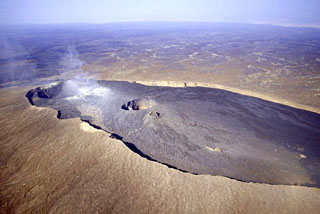Report on Erta Ale (Ethiopia) — February 2004
Bulletin of the Global Volcanism Network, vol. 29, no. 2 (February 2004)
Managing Editor: Edward Venzke.
Erta Ale (Ethiopia) February 2004 expedition finds molten-surfaced lava lake nearly gone
Please cite this report as:
Global Volcanism Program, 2004. Report on Erta Ale (Ethiopia) (Venzke, E., ed.). Bulletin of the Global Volcanism Network, 29:2. Smithsonian Institution. https://doi.org/10.5479/si.GVP.BGVN200402-221080
Erta Ale
Ethiopia
13.601°N, 40.666°E; summit elev. 585 m
All times are local (unless otherwise noted)
In February 2004 an expedition led by German scientists visited Erta Ale. Afterwards, an overflight completed the survey of volcanic activity. Of significance was the discovery that an earlier lava lake had largely disappeared. Information from their report follows.
German scientists were at Erta Ale during 9-13 February 2004. They explored areas around the S crater of the volcano, which for the past several years has contained an active lava lake (see BGVN 28:04 and 26:12). The S crater retained only a very small fraction of the former lava lake. When visited it stood ~ 15 m in diameter, located roughly in the center of the old lake. Around the small lake were many active gas vents, and there was a hornito, about 2 m tall, on the SE side. Behind its ~ 1.5-m-high walls, the lake's lava changed levels and occasional lava fountains rose to ~ 10 m high.
On 12 February the expedition team descended to the second terrace (~90 m below the rim) of the S crater, to the surface of the former lake, and approached the small elevated lake. Samples of newly ejected lava were collected, and some were given to Gezahegn Yirgu at the University of Addis Ababa for analysis. Samples retained by the expedition team showed white crystals, approximately 1-2 mm in size, embedded in black material. On the evening of 12 February the team witnessed an overflow of the little lake, flooding the NW half of the second terrace. Parts of the western lake wall eventually collapsed, causing a lava flood wave as well as more violent fountaining (up to 20 m). This event lasted approximately 2 hours.
The entire crater was fogged by fumaroles, which were mainly active in the SE corner of the first terrace (~ 50 m below the rim). Gas masks were necessary inside the crater. From the smell and (blueish) color, these gases contained a high quantity of SO2.
No earthquakes were felt during the visit.
On 21 February a low overflight was made across the volcano. There were no more signs of a lava lake, and only three hornitos were active. Although the flight was made during the day, the glow allowed the hornitos to be visible. Upon return, Chris Heinlein noted that he found photos on the web by Luigi Cantamessa showing that during 15-17 November 2003 the lava lake was also largely gone.
Geological Summary. The Erta Ale basaltic shield volcano in Ethiopia has a 50-km-wide edifice that rises more than 600 m from below sea level in the Danakil depression. The volcano includes a 0.7 x 1.6 km summit crater hosting steep-sided pit craters. Another larger 1.8 x 3.1 km wide depression elongated parallel to the trend of the Erta Ale range is located SE of the summit and is bounded by curvilinear fault scarps on the SE side. Basaltic lava flows from these fissures have poured into the caldera and locally overflowed its rim. The summit caldera usually also holds at least one long-term lava lake that has been active since at least 1967, and possibly since 1906. Recent fissure eruptions have occurred on the N flank.
Information Contacts: Carsten Peter, Meilenbergerstr. 1, D-82057 Icking-Dorfen, Germany; Chris Heinlein, Kreuzelbergstr. 62, 76189 Karlsruhe, Germany; Arne Kaiser, Institute of Geophysics, University of Hamburg, Bundesstraβe 55, 20146 Hamburg, Germany; Luigi Cantamessa, Geó-Découverte, 12-14 rue de Cendrier, CH-1201 Geneva, Switzerland (URL: http://geo-decouverte.ch/); Gezahegn Yirgu, Department of Geology and Geophysics, Faculty of Science, Addis Ababa University, P.O. Box 1176, Addis Ababa, Ethiopia (URL: http://www.aau.edu.et/natural-sciences/geology/).

